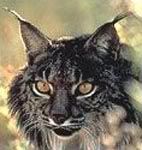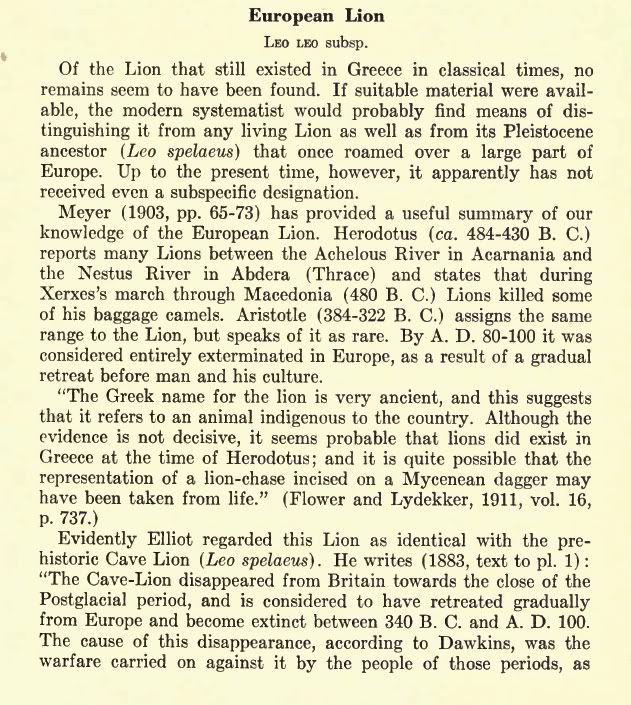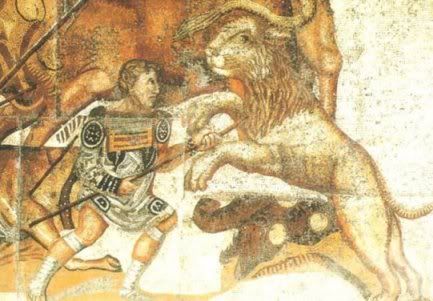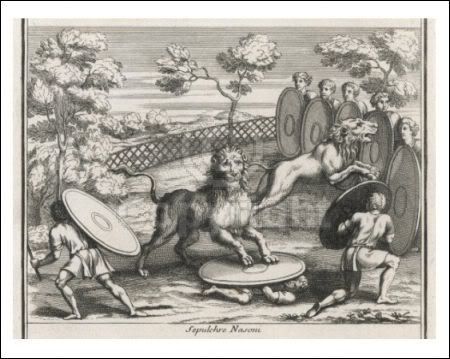|
|
Post by Carlos on Jan 13, 2007 17:44:52 GMT
The latest wave hypothesis of modern lion evolution: is lion man’s best company? Nobuyuki Yamaguchi1, Alan Cooper2, Lars Werdelin3 & David. W. Macdonald1 1 Wildlife Conservation Research Unit, Department of Zoology, Oxford University, UK 2 Henry Wellcome Ancient Biomolecules Centre, University of Oxford, UK 3Department of Palaeozoology, Swedish Museum of Natural History, Stockholm, Sweden The evolutionary history of the lion (Panthera leo) began in Pliocene east Africa, as open habitats expanded towards the end of the Cenozoic. In a pattern similar to that described for hominids, the African lion’s distribution expanded dramatically in the middle Pleistocene. Lions spread to Europe by c. 0.5 Myr, most parts of Eurasia, North America (at c. 0.3 Myr), and may have eventually reached as far south as Peru. The first lions were presumably maneless, and Palaeolithic cave art strongly suggest that maneless form persisted at least in Europe up until c. 10 thousand years ago (Kyr). On the other hand, art and artefact in south-western Eurasia and north eastern Africa recorded many big maned lions as early as the inception of the regional civilizations c. 6 - 5.5 Kyr. Based on mitochondrial 12S RNA and cytochrome b sequences, the modern lion that ubiquitously possesses the mane is suggested to have experienced a bottleneck as recently as c. 300 - 200 Kyr. We suggest that the maned modern lion may have replaced the earlier maneless types throughout Africa and western Eurasia by historic times, before being halted by climate change and direct competition from humans. This "Latest Wave Hypothesis" of modern lion evolution is similar to the "Recent African Origin Model" of modern human evolution whereby Homo sapiens replaced earlier hominids outside Africa. www.systass.org/biennial2003/SA_4th_Biennial_Abstracts_only.rtf |
|
|
|
Post by Carlos on Jan 13, 2007 18:05:01 GMT
|
|
|
|
Post by Carlos on Jan 23, 2007 22:00:54 GMT
RS Sommer, N Benecke (2006)
Late Pleistocene and Holocene development of the felid fauna (Felidae) of Europe: a review
Journal of Zoology 269 (1), 7–19.
Abstract:
In the fossil deposits of the Late Pleistocene (c. 115 000–11 500 years ago), five felid species are recorded in Europe: the wildcat Felis silvestris, Eurasian lynx Lynx lynx, Iberian lynx Lynx pardinus, leopard Panthera pardus and cave lion Panthera leo spelaea. In the Holocene, Europe was colonized by F. silvestris, L. lynx and L. pardinus as well as the lion Panthera leo. The status of P. pardus in post-glacial Europe is unknown. So far, only sparse records indicate that P. pardus survived into the early Holocene. During the Late Glacial, both L. lynx and L. pardinus occurred on the Iberian Peninsula. However, from the Holocene, only the Iberian lynx is recorded in this region. There are subfossil records that indicate that L. pardinus also occurred in central and western France until c. 3000 years ago. Surprisingly, with reservations on the determination of the bones (by J. Altuna), both lions and cave lions seem to be recorded in the Iberian Peninsula in the Late Glacial. There are published records of the lion P. leo in the northern Iberian Peninsula from the early Holocene. However, its presence in Europe on the basis of subfossil records was proven initially from the Atlantic period. In Ponto-Mediterranean regions of Europe, the lion is recorded from the Atlantic to the younger sub-Atlantic.
|
|
|
|
Post by another specialist on Jan 23, 2007 23:40:17 GMT
Thanks Carlos very interesting indeed.
|
|
|
|
Post by another specialist on Jan 23, 2007 23:45:08 GMT
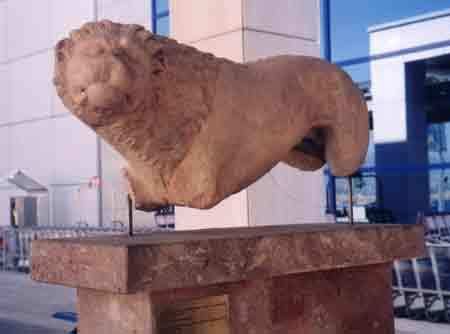 This lion stands guard outside the new Athens Airport. Apparently, when the site for the airport was being excavated, the workers came across this magnificent statue, dating from early BC! 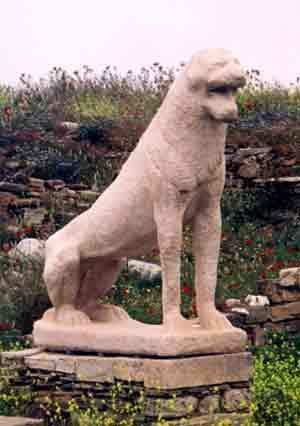 This is called "The Laughing Lion." You can find him on the Greek island of Delos, which is a very small but important island.  Here's another Greek lion statue presently residing in the Antiquities Museum on Delos. |
|
|
|
Post by Peter on Aug 11, 2007 10:27:55 GMT
I known there is a proposal on Wikipedia to delete the European Lion Lemma (http://en.wikipedia.org/wiki/European_Lion). In order to preserve it: European Lion Conservation status: Extinct Scientific classification Kingdom: Animalia Phylum: Chordata Class: Mammalia Order: Carnivora Family: Felidae Genus: Panthera Species: P. leoSubspecies: P. l. europaeaTrinomial name: Panthera leo europaeaSynonyms: P. leo tartarica (Serbia) The European lion ( Panthera leo europaea) or ( Panthera leo tartarica) could be an extinct subspecies of lion that inhabited southern Europe until historic times. This population is generally considered part of the Asiatic lion ( Panthera leo persica), but others consider it a separate subspecies, the European lion (Panthera leo europaea). They also could possibly have been the last remnants of the Cave lion ( Panthera leo spelea). Two prehistoric lions lived in Europe, namely the Early Middle Pleistocene European cave lion Panthera leo fossilis and the Upper Pleistocene European cave lion Panthera leo spelaea.[1] DistributionThe European lion in historic times inhabited the Iberian Peninsula, southern France, Italy and Balkans south to northern Greece.(In russian)[citation needed] This was the northermost of the subspecies of lion until its extinction. Its habitat was the Mediterranean and temperate forests of the area, with prey that included the wisent, elk, aurochs, deer and other European ungulates. ExtinctionDue to their remote extinction, little is known about these subspecies of lion. Aristotle and Herodotus wrote that lions were found in the Balkans in the middle of the first millennium B.C. When Xerxes advanced through Macedon in 480 B.C. he encountered several lions.[2] Before 20 B.C. they became extinct from Italy and around the year 1 from Western Europe.[3][citation needed] Around the year 70 they were restricted to northern Greece, in the area between the rivers Aliakmon and Nestus.[citation needed] Finally, in the year 100 they became extinct in Eastern Europe too.[4][citation needed] After that lions in the European continent became restricted to the Caucasus, where a population of the Asiatic lion survived until the 10th century.[citation needed] The European Lion became extinct due to excessive hunting (lion hunting was popular among the Macedonians, Greeks and Romans), over-exploitation, and competition with feral dogs. Along with the Barbary lion and the Asiatic lion the European lion was used in the Roman arenas, where they fought against bestiarii, and animals like the Caspian tiger, the aurochs and bears. Due to geographical distribution they were more accessible to Romans than North African and Middle Eastern lions. When the European lion was walking toward extinction, Romans began to import lions from North Africa and the Middle East to fight in the arenas. Further details about their extinction are unknown. See alsoAsiatic Lion Cave Lion Lion References* Burger J, Rosendahl W, Loreille O, Hemmer H, Eriksson T, Götherström A, Hiller J, Collins MJ, Wess T, Alt KW. (2004). Molecular phylogeny of the extinct cave lion Panthera leo spelaea. Mol. Phylogenet. Evol., 30, 841–849. Online pdf * Asiatic Lion Information Centre. 2001 Past and present distribution of the lion in North Africa and Southwest Asia. Downloaded 1 June 2006 from www.asiatic-lion.org/distrib.html. * Guggisberg, C.A.W. 1961. Simba: the life of the lion. Howard Timmins, Cape Town. |
|
|
|
Post by another specialist on Aug 11, 2007 11:01:35 GMT
The presence of the Asian Lion in Europe was attested by Herodotus and Aristotle. Herodotus recorded how Xerxes' Persian invasion army of 480 BC was attacked by lions while bivouaking on the eastern fringes of Greece and Macedonia. This happened during the night and the lions restricted their attack solely to Xerxes' pack-camels. Herodotus claims that the habitat of lions in Europe was small and was confined by the Nestus and Achelous rivers (Herodotus VII, 124-126). It is generally assumed that around 80-100 AD the Asian lion had become extinct in Greece and in the rest of Europe. www.pothos.org/alexander.asp?paraID=103&keyword_id=6&title=Lions |
|
|
|
Post by temujin on Aug 31, 2007 14:14:38 GMT
Some days ago i found in my house an encyclopedia about lions.In that encyclopedia they stated that the lions from Balkans belonged to the Cave lion.And about the presence of lions in Europe,i found that information: "The lion has been know since ancient times as the "king of the beasts". Large, majestic and agile,it once ranged over a wide territory. As late as 500 B.C., lions roamed over eastern Europe as far west as Italy, the Near East from Turkey to India, throughout Arabia and all Africa from Gibraltar to the Cape of Good Hope". Source: moggycat13.tripod.com/id76.html |
|
|
|
Post by another specialist on Aug 31, 2007 18:17:06 GMT
The European lion (Panthera leo europaea) or (Panthera leo tartarica) could be an extinct subspecies of lion that inhabited southern Europe until historic times. This population is generally considered part of the Asiatic lion (Panthera leo persica), but others consider it a separate subspecies, the European lion (Panthera leo europaea). They also could possibly have been the last remnants of the Cave lion (Panthera leo spelea). Two prehistoric lions lived in Europe, namely the Early Middle Pleistocene European cave lion Panthera leo fossilis and the Upper Pleistocene European cave lion Panthera leo spelaea.[1] Distribution The European lion in historic times inhabited the Iberian Peninsula, southern France, Italy and Balkans south to northern Greece.(In russian)[citation needed] This was the northermost of the subspecies of lion until its extinction. Its habitat was the Mediterranean and temperate forests of the area, with prey that included the wisent, elk, aurochs, deer and other European ungulates. Extinction Due to their remote extinction, little is known about these subspecies of lion. Aristotle and Herodotus wrote that lions were found in the Balkans in the middle of the first millennium B.C. When Xerxes advanced through Macedon in 480 B.C. he encountered several lions.[2][3] Before 20 B.C. they became extinct from Italy and around the year 1 from Western Europe.[4][citation needed] Around the year 70 they were restricted to northern Greece, in the area between the rivers Aliakmon and Nestus.[citation needed] Finally, in the year 100 they became extinct in Eastern Europe too.[5][citation needed] After that lions in the European continent became restricted to the Caucasus, where a population of the Asiatic lion survived until the 10th century.[citation needed] The European Lion became extinct due to excessive hunting (lion hunting was popular among the Macedonians, Greeks and Romans), over-exploitation, and competition with feral dogs. Along with the Barbary lion and the Asiatic lion the European lion was used in the Roman arenas, where they fought against bestiarii, and animals like the Caspian tiger, the aurochs and bears. Due to geographical distribution they were more accessible to Romans than North African and Middle Eastern lions. When the European lion was walking toward extinction, Romans began to import lions from North Africa and the Middle East to fight in the arenas. Further details about their extinction are unknown. en.wikipedia.org/wiki/European_lion |
|
|
|
Post by temujin on Sept 7, 2007 14:29:39 GMT
I found this site today: www.tigertouch.org/cats/lion.htmlI see how those sites are unclear about the lion's habitat in Europe: The lion may be found in all parts of Africa south of the Sahara and in the Gir Forest of India and, until recently, in all parts of the Near East and on the Balkan and Iberian Peninsulas of Europe, where it hunts by night or day, from the ground, and seeks game of all types. In my personal opinion,Iberian Peninsula has a adequate habitat for lions,as his terrain,climate,vegetation and soil is more similar to North Africa than Europe north of the Pyrenneans,wich is more adequated to tigers. |
|
|
|
Post by Carlos on Sept 7, 2007 15:25:20 GMT
It seems, (information posted elsewhere in this Forum), that both species, Panthera spelaea and Panthera leo were to be found together for a short time in the Iberian Peninsula, before the maneless species retreated and dissapeared forever in the transition period from Pleistocene to full Holocene.
Much later on, the maned one also dissapeared.
|
|
|
|
Post by Melanie on Sept 10, 2007 21:09:39 GMT
|
|
|
|
Post by another specialist on Sept 11, 2007 20:01:24 GMT
|
|
|
|
Post by temujin on Sept 12, 2007 4:01:28 GMT
Yes,could be.Or an Asiatic lion too. |
|
|
|
Post by another specialist on Sept 12, 2007 6:39:51 GMT
Yes, possibility but it doesn't represent a barbary lion for sure
|
|
|
|
Post by temujin on Mar 28, 2008 15:40:52 GMT
I buyed some days ago a ancient maganize about Big cats,from 1991.In this maganize there are a map of the range of the lion(unfortelly i don't have scanner),and in this map shows a lion distribution extending in Europe from southern Spain to Thrace, passing throught eastern Spain,southern France(Narbonne,Languedoc,Camargue,Rhone area),almost all of Italy and western and southern Balkans.Acording to this map,the lion distribution in this area of Europe don't exceeds much the litoranean area of the Mediterranean,in the areas of the maquis and guarrigues vegetation.Also this map shows the lion range in Asia reaching Transcaucasia(Armenia and southern parts of Georgia and Azerbaijan),all of Iran(incluind the northern Caspian provinces like Mazandaran,Ardebil and Golestan) and even Transoxiana(Turkmenistan and southern Uzbekistan;the area south of the ancient Oxus river[Amu-Daria in the now days]),all of India and the border between Bangladesh and Myanmar.But this maganize didn't mentions the european subspecies of lion.
|
|
|
|
Post by another specialist on Mar 29, 2008 10:32:31 GMT
|
|
|
|
Post by surroundx on Sept 4, 2016 2:08:37 GMT
|
|


